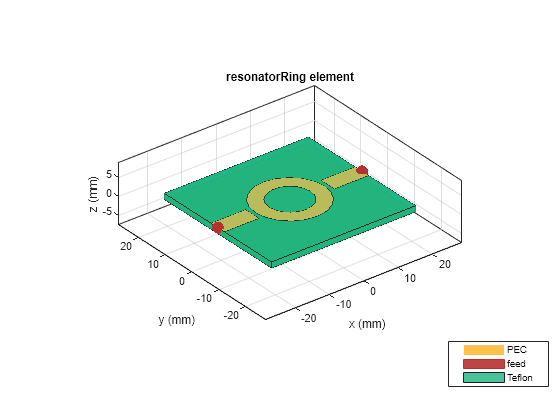resonatorRing
Description
Use the resonatorRing object to create a gap-coupled ring
resonator in the microstrip form. Resonant structures such as rectangular, circular, and ring
resonators are used in oscillators and filters.

Creation
Description
resonator = resonatorRing creates a default gap-coupled ring
resonator. The default properties of the ring resonator are for a design frequency of 1
GHz.
resonator = resonatorRing( sets
Properties using one or more
name-value arguments. For example, Name=Value)resonatorRing(RingWidth=0.045)
creates a ring resonator with a ring width of 0.045 meters.
Properties not specified retain their default values
Properties
Object Functions
charge | Calculate and plot charge distribution |
current | Calculate and plot current distribution |
design | Design ring resonator around specified frequency |
feedCurrent | Calculate current at feed port |
getZ0 | Calculate characteristic impedance of transmission line |
layout | Plot all metal layers and board shape |
mesh | Change and view mesh properties of metal or dielectric in PCB component |
shapes | Extract all metal layer shapes of PCB component |
show | Display PCB component structure or PCB shape |
sparameters | Calculate S-parameters for RF PCB objects |
RFConnector | Create RF connector |
Examples
References
[1] Pozar, David.M. Microwave Engineering Singapore; JohnWiley and Sons. Inc, 2012.
[2] Bogner, Andreas, Carsten Steiner, Stefanie Walter, Jaroslaw Kita, Gunter Hagen, and Ralf Moos. Planar Microstrip ring resonators for Microwave-Based Gas Sensing: Design Aspects and Initial Transducers for Humidity and Ammonia Sensing.
[3] Bernard, P.A., and J.M. Gautray. “Measurement of Dielectric Constant Using a Microstrip Ring Resonator.” IEEE Transactions on Microwave Theory and Techniques 39, no. 3 (March 1991): 592–95.

